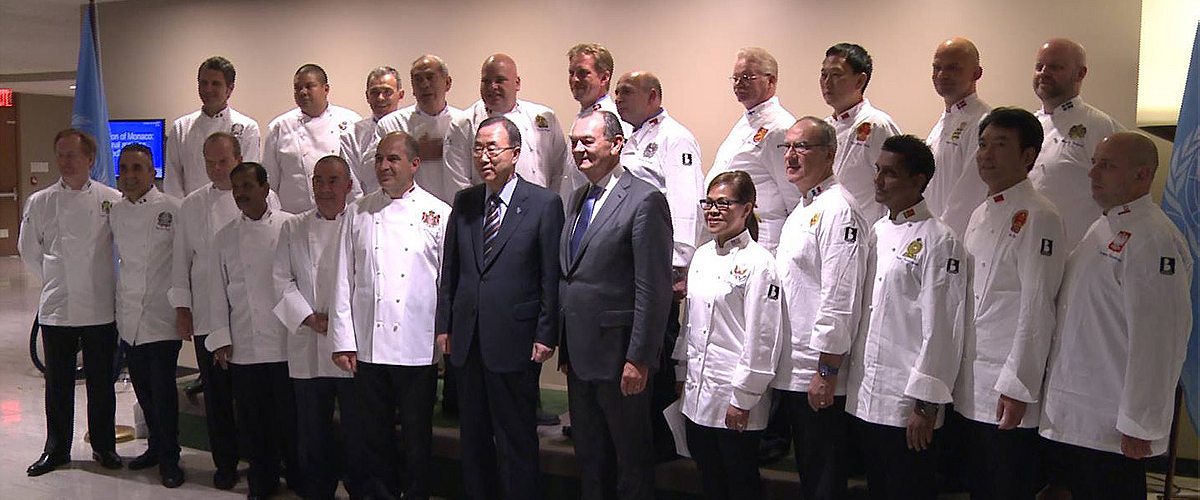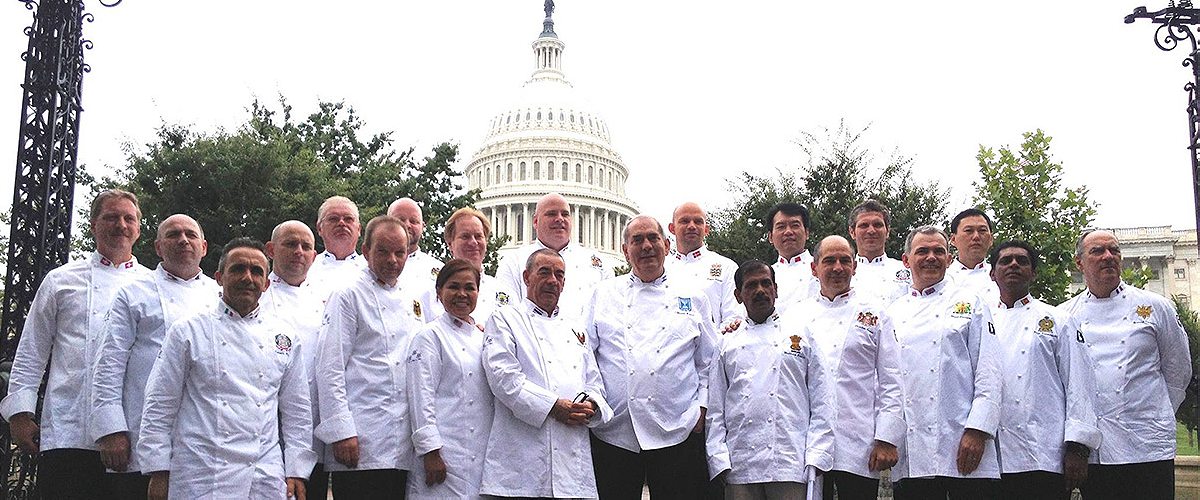To be a member of Le Club des Chefs des Chefs, there is just one qualification: you must be the personal chef to a current head of state.
A week ago, the chef to the French President was serving François Hollande, as he does regularly. But tonight in Washington DC, he’s a guest, serving himself at a buffet line of high-end American comfort food: fried chicken, collard greens, fresh corn and tomato salad. Off duty and dressed neatly in a polo shirt and slacks, he places a piece of fried chicken on his own plate, then picks up another in the tongs, and with a gracious nod, places a crispy drumstick on the plate of the person behind him in line. The habit of hospitality, it seems, does not take a vacation, even when the chef does. The delighted guest can barely say, “Merci,” before the chef, Bernard Vaussion, weaves back into the crowd comprised both of his counterparts—among them the chefs for Queen Elizabeth, for King Bhumibol Adulyadej of Thailand, for German Chancellor Angela Merkel—and of American culinary royalty: Celeb chefs Rick Bayless, Ming Tsai, Amanda Freitag, Marc Murphy and Art Smith.
The casual late-night dinner at Smith’s Art & Soul restaurant, below a string of tungsten bulbs and clouds that parted just in time, closed a week-long visit to the United States by Le Club des Chefs des Chefs (say it out loud; it’s delightful), a global affiliation of chefs who cook for heads of state. The group was founded in 1977 not so much as a professional union, but as “the world’s most exclusive gastronomic society,” according to their website. Each year this traveling pack of elite gourmets gathers in a different country to eat, socialize and talk about their very particular jobs, which often demand both the intimacy of a mother cooking for her child, and the grandeur and military precision of orchestrating 1000-person state dinners.

This year’s trip was to the United States, and put some do-gooding and policy discussion on the itinerary along with the usual shop talk and dining. The week began in New York where the chefs met with United Nation’s secretary general Ban Ki-moon, dined upstate at Blue Hill Stone Barns and collaborated on an international meal that they served at a Harlem soup kitchen; to Lancaster, Pennsylvania where they lunched at an Amish farm (“It was like a kibbutz,” observed Shalom Kadosh, the long-time chef for Israeli presidential receptions. “The people cook with heart.”) And to DC where they met with President Obama at the White House.
Earlier today the international contingent met with the American Chef Corps, a group of notable U.S. chefs, including Bayless, Murphy, et al, who work with the State Department to feed visiting dignitaries or promote American cuisine and culture during their (privately funded) foreign travels. Their host was the only member of both groups, White House executive chef Cristeta Comerford. The corps, she says, “represents the country with the best cuisine we can offer as American chefs.”
“The idea is to include food into diplomacy,” says Maziar Farivar, the Iranian-born chef of the long-standing Georgetown restaurant Peacock Café who is among the corps’ 60 members. “It started when the Israeli delegation was here. There were hours of negotiation, but nobody was paying attention to what they were eating, to what they liked. There were complaints. Next time they invited somebody [to cook] who was familiar with what they like, and it was a comfort. So they figured, ‘Let’s put more thought into this’.”
Hillary Clinton likes sweet potatoes. Biden will eat anything.
“If you’re hungry, you won’t get anything done. The only time my wife and I argue is if I’m hungry,” says Ming Tsai, the Wellesley, Mass-based Chinese American chef who made the first foreign chef corps trip, to Portugal; tonight he has done a bit of translating for the two Chinese chefs. Tsai, also host of the PBS show, Simply Ming, has sometimes provided meals during diplomatic talks. Knowing your audience is key, he says. “The Chinese don’t like salads of raw vegetables, they prefer soup. Hillary Clinton likes sweet potatoes. Biden will eat anything.”

After a State Department reception hosted (<em>Chefs des Chefs</em> were clad in whites, American Chefs Corps members in black uniforms; they looked like a gathering of opposing ninjas), both groups change into street wear and gather to relax. Chef Smith, a James Beard Award-winner with restaurants in five states, admitted to nerves before entertaining this lofty group. He is among the chef corps, but he doesn’t cook the sort of food typically served under a silver cloche. Instead, he opted for his famous fried chicken and lamb roasted on a spit. “The event was not for us to show off, but to show the real America,” Smith says, adding, “George Washington’s favorite meal was barbecue lamb. And to leave our beautiful nation’s capitol and not to have real American fried chicken, Rappahannock Oysters, Virginia lamb and pie? That would be sad!” Tragedy is thwarted by peach pie and lemon pie and chocolate cream pie. “I picked foods that I love,” says Smith. “That’s key to great menu planning: People love what you love to cook.”
At the bar, the chefs gather to do what they do best (besides cooking, that is): drink and tell stories. Israel’s Chef Koresh chats (in English) with Prince Albert of Monaco’s chef. The German chef to Angela Merkel and the two chefs from China’s Great Hall of the People shared no common language but this did not stop them from sharing some beers. Several chefs were happily queued at the bourbon bar for cocktails. A jazz quartet played American standards, relieved during their breaks by a deejay; the Danish chef was spotted rocking out to Michael Jackson.
Getting specifics about the culinary predilections of any head of state is virtually impossible.
Even when cutting loose, they are a discreet group. Getting specifics about the culinary predilections of any head of state is virtually impossible. Jesper Vollmer, chef to Denmark’s royal family, says they eat out a fair amount—yes, curious foodies: they have been to Noma—so when they eat at home they prefer simplicity. “When I first started the Queen used to say to me, ‘It’s too much like a restaurant. Make it less fancy.” Hearing this, Jan Van Haute, the former chef for Belgium’s royal family says, “I had that too. Sometimes they really need spaghetti. They’re human.”
Pushed for a crumb of information on whether a celebratory cake was served to mark the arrival of wee Prince George, Mark Flanagan, chef to Queen Elizabeth, would only smile politely and say what a joyous occasion it was. I’m told that the King and Queen of Sweden are very healthy eaters: No forbidden foods, but they eat very small portions, usually two courses at lunch and dinner. Small portions of what? The Swedish chef, Magnus Ake Rehback, who has a full command of English and a sly sense of humor, will not say. The only one willing to divulge any nugget along these lines is the affable chef from Monaco, Christian Garcia, who is the current Chef des Chefs president. Even then, he will speak only of Prince Rainier, who has been dead since 2005. Princess Grace had introduced Rainier to fried chicken and once after her death he asked Garcia to prepare it. He did so from a recipe, and admits he didn’t get it quite right, and His Serene Highness let him know it. (Earlier in the evening, the discovery of an odd bit of synergy: Albert of Monaco, when he was a student at Amherst, once babysat for American chef Marc Murphy, now a star of Chopped, when Murphy’s father was in the foreign service.)
Among themselves, however, the <em>Chefs des Chefs</em> frequently discuss what their bosses do and don’t eat. Before one head of state visits another, the chef for the host country will contact the chef of the visiting dignitary. They talk food allergies, keeping kosher or halal—even just what the King had the night before, so as not to repeat. “We call each other up: ‘What do they like? What should I stay away from?’ If it’s the Queen of England, we’ll be 90 percent sure she will be satisfied,” says Denmark’s Vollmer. Again, discretion: “If the prime minister of Israel is coming and they say his favorite food is broccoli, we don’t let that get out,” cautions Timothy Wasylko, chef to Canada’s Prime Minister. “Otherwise everywhere he goes everyone will give him broccoli.”
Of course, not every visitor leaves it to the network of chefs to plan a menu. Jan Van Haute of Belgium recalls when South Korea’s First Lady was visiting the Queen, “she wanted to teach me how to cook Korean. She gave me a list of ingredients, and then she came by herself for a few hours into the kitchen and was cooking with me. It was amazing.”
Most chefs are working within their own national cuisine, save for a few transplants. Comerford was born in Manila, but has lived in the States since her early 20s. The chef to Thailand’s King is the Italian-born Norbert Kostner, and the chef to the President of Gabon moved from Scotland to take the job. “When I interviewed in London, I didn’t know where the job was,” says Ferrier Richardson. After a three-month trial period in Gabon, he came to love it and now cooks almost all of the President’s meals. Did you have to learn Gabonese cuisine? I ask. No, the President has lived in Britain and America, and his wife is French-Moroccan, “so I cook mostly European,” says Richardson. “And when he wants Gabonese food, his mother comes in.”
When the evening ends, after a multi-lingual round of “good-byes,” the chefs pile back onto a chartered bus, looking like any other band of tourists moving through the capitol as a pack. The difference being that some 20 kings and queens, presidents and prime ministers around the world hungrily await their arrivals home.